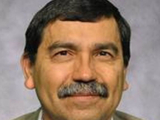GESTAR II Seminar Series, May 19 - POSTPONED
Featured Speaker: Dr. Jose D. Fuentes
(Note: this talk will be rescheduled at a later date.)
Dr. Jose D. Fuentes, Professor of Atmospheric Science, Penn State University, will present a talk titled "Arctic Climate Change and Cycles of Trace Gases." Dr. Fuentes is an Associate Director of GESTAR II.
Date and Time: To Be Determined
Abstract:
The Arctic is experiencing the most dramatic environmental changes. Manifestations of such changes are the loss of perennial ice and the formation of thinner, seasonal ice. Such changes are causing a wide range of impacts and feedbacks on regional climate and chemical cycles, including greater amounts of water vapor transport from winter--time leads to the overlying atmospheric boundary layer. Changes in sea ice impact the chemistry and the chemical composition of the lower atmosphere as well as aerosol physical and chemical composition. Therefore, this presentation will describe the features of field campaigns to advance knowledge of emissions, transport, and chemistry of halogens such as chlorine, bromine, and iodine above the snowpack on the tundra near Utqiagvik, Alaska. Field campaigns took place during the last ten years and provided key data sets to assess the influences of atmospheric thermodynamics and turbulence on halogen chemistry and thus estimate the impacts of halogens on the composition of the Arctic boundary layer. Air turbulence and chemistry measurements were made on fixed flux towers above the frozen tundra and on aircrafts.
Biography:
Jose D. Fuentes is a Professor of Atmospheric Science at the Pennsylvania State University where he teaches undergraduate- and graduate-level courses in Micrometeorology, Biometeorology, and Air Chemistry. His research focuses on surface-atmosphere interactions related to emissions, turbulent transport, surface deposition, and chemistry of reactive gases and aerosols. Since 2000, he and his students have investigated the role of the snowpack in the emissions and surface deposition of ozone, halogens, mercury, and aerosols. To complete his field studies, he employs flux towers and tethered balloons which have been deployed at several sites in the Arctic. He has also contributed to the development of numerical models to investigate the chemistry of halogens and the aerosol formation in the Arctic atmospheric boundary layer during the springtime. He serves on many advisory boards, including the Committee on Equal Opportunities in Science and Engineering (CEOSE), which is a congressionally mandated advisory committee to the National Science Foundation. As the current chair of CEOSE, he seeks to identify national strategies to broaden the participation of under-represented groups in science, technology, engineering, and mathematics.
Tags:
Posted: May 16, 2022, 12:04 PM
